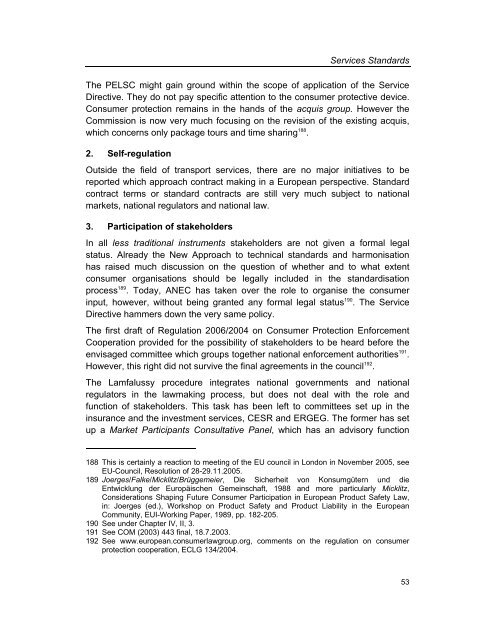Services Standards: Defining the Core Consumer Elements ... - ANEC
Services Standards: Defining the Core Consumer Elements ... - ANEC
Services Standards: Defining the Core Consumer Elements ... - ANEC
You also want an ePaper? Increase the reach of your titles
YUMPU automatically turns print PDFs into web optimized ePapers that Google loves.
<strong>Services</strong> <strong>Standards</strong><br />
The PELSC might gain ground within <strong>the</strong> scope of application of <strong>the</strong> Service<br />
Directive. They do not pay specific attention to <strong>the</strong> consumer protective device.<br />
<strong>Consumer</strong> protection remains in <strong>the</strong> hands of <strong>the</strong> acquis group. However <strong>the</strong><br />
Commission is now very much focusing on <strong>the</strong> revision of <strong>the</strong> existing acquis,<br />
which concerns only package tours and time sharing 188 .<br />
2. Self-regulation<br />
Outside <strong>the</strong> field of transport services, <strong>the</strong>re are no major initiatives to be<br />
reported which approach contract making in a European perspective. Standard<br />
contract terms or standard contracts are still very much subject to national<br />
markets, national regulators and national law.<br />
3. Participation of stakeholders<br />
In all less traditional instruments stakeholders are not given a formal legal<br />
status. Already <strong>the</strong> New Approach to technical standards and harmonisation<br />
has raised much discussion on <strong>the</strong> question of whe<strong>the</strong>r and to what extent<br />
consumer organisations should be legally included in <strong>the</strong> standardisation<br />
process 189 . Today, <strong>ANEC</strong> has taken over <strong>the</strong> role to organise <strong>the</strong> consumer<br />
input, however, without being granted any formal legal status 190 . The Service<br />
Directive hammers down <strong>the</strong> very same policy.<br />
The first draft of Regulation 2006/2004 on <strong>Consumer</strong> Protection Enforcement<br />
Cooperation provided for <strong>the</strong> possibility of stakeholders to be heard before <strong>the</strong><br />
envisaged committee which groups toge<strong>the</strong>r national enforcement authorities 191 .<br />
However, this right did not survive <strong>the</strong> final agreements in <strong>the</strong> council 192 .<br />
The Lamfalussy procedure integrates national governments and national<br />
regulators in <strong>the</strong> lawmaking process, but does not deal with <strong>the</strong> role and<br />
function of stakeholders. This task has been left to committees set up in <strong>the</strong><br />
insurance and <strong>the</strong> investment services, CESR and ERGEG. The former has set<br />
up a Market Participants Consultative Panel, which has an advisory function<br />
188 This is certainly a reaction to meeting of <strong>the</strong> EU council in London in November 2005, see<br />
EU-Council, Resolution of 28-29.11.2005.<br />
189 Joerges/Falke/Micklitz/Brüggemeier, Die Sicherheit von Konsumgütern und die<br />
Entwicklung der Europäischen Gemeinschaft, 1988 and more particularly Micklitz,<br />
Considerations Shaping Future <strong>Consumer</strong> Participation in European Product Safety Law,<br />
in: Joerges (ed.), Workshop on Product Safety and Product Liability in <strong>the</strong> European<br />
Community, EUI-Working Paper, 1989, pp. 182-205.<br />
190 See under Chapter IV, II, 3.<br />
191 See COM (2003) 443 final, 18.7.2003.<br />
192 See www.european.consumerlawgroup.org, comments on <strong>the</strong> regulation on consumer<br />
protection cooperation, ECLG 134/2004.<br />
53
















